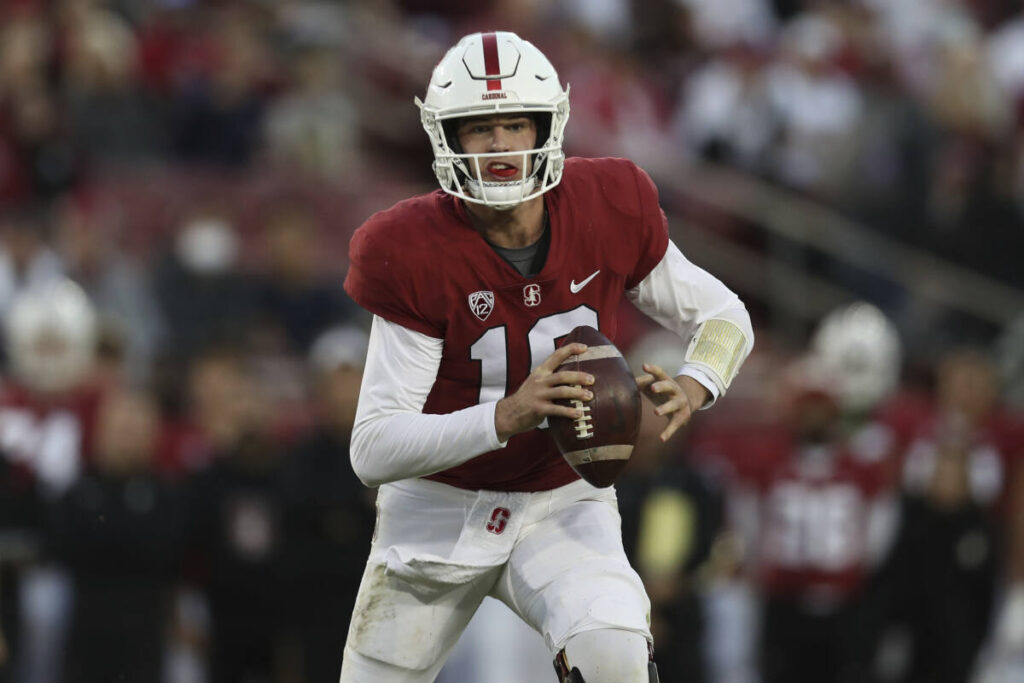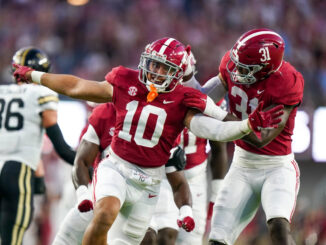This year’s quarterback class has plenty of star power. There are a number of names receiving first round buzz and it feels like we could see three quarterbacks taken in the top five for just the second time since the turn of the millennium. Here are my top ten quarterbacks in the 2023 NFL Draft.
You can also download our free 2023 NFL Draft Guide, with over 130 in-depth prospect profiles!
1. Anthony Richardson, Florida (6-4, 244, rs-Sophomore)

Pros: Richardson possesses the greatest collection of physical tools we have seen at quarterback in the last decade. He has a rocket launcher for an arm and does not need to set his feet to generate impressive velocity. He is also one of the most electric athletes at the quarterback position we have seen in a generation, logging a perfect 10.00 Relative Athletic Score. He ticks the mental boxes too. Richardson is comfortable identifying coverage rotations and working through his reads. His 9.2% pressure to sack rate is also the lowest in the entire class.
Cons: Mechanics are by far Richardson’s biggest issue. Bouncy footwork and an inconsistent base causes all sorts of problems with his accuracy and ball placement. His 64.1% adjusted completion percentage ranked 141st of 155 FBS quarterbacks in 2022. He is also incredibly inexperienced, with just 455 career dropbacks and one season as a starter in college to his name.
Projection: 1st round
2. CJ Stroud, Ohio State (6-3, 214, rs-Sophomore)

Pros: Stroud offers exceptional accuracy at all three levels of the field. He has an advanced understanding of how to throw with touch and placement that you don’t often see in college quarterbacks. He is a competent processor too, who showcases the ability to work through his progressions and get to the back side of full field reads. His arm strength is good and won’t look out of place at the NFL level. Stroud also flashed some nice creation capacity when asked to operate out of structure.
Cons: He doesn’t have the elite physical tools you see in most top quarterbacks. His arm is good but not elite, and he isn’t going to be much of a threat as a designed rusher. Whilst he did flash some promise as an out of structure passer, he didn’t do this consistently during his college career. He also struggles when faced with pressure, particularly when it prevents him from stepping up and climbing the pocket.
Projection: 1st round
3. Bryce Young, Alabama (5-10, 204, rs-Sophomore)

Pros: You won’t find many college quarterbacks who show the poise and pocket presence of Young. His ability to calmly navigate pressure is outstanding and projects very well to the NFL level. He is also incredibly accurate, showing the ability to throw with touch and anticipation. He is a good athlete who showed that he has the ability to threaten defenses as a play extender or as a designed runner. He is also far tougher than you might expect for a quarterback of his size.
Cons: The big question mark with Young is his size. He bulked up for the Combine but he was listed at just 194 lbs at Alabama and there are rumours that his playing weight was even lower than that. He would be the lightest first round quarterback in decades and easily the lightest starter in the NFL. His arm strength is good but definitely nothing special, and he has had issues with his lower body mechanics in college.
Projection: 1st round
4. Will Levis, Kentucky (6-4, 229, rs-Senior)

Pros: Levis has a howitzer for an arm that would rank amongst the top tier in the NFL. The velocity he generates is impressive and does not seem to depreciate substantially when he is throwing off platform. Levis’ toughness in the pocket is commendable and he is not afraid of taking hits if it allows him to make big plays. He is also a good athlete who has the size and power to be a weapon in short yardage situations. Levis has the added benefit of having experience operating a pro-style offense at Kentucky.
Cons: Whilst the tools are all there, the refinement is not. Levis still has a long way to go as a decision maker and there are some truly terrifying mistakes littered throughout his tape. He is slow to progress through his reads, an issue that will only worsen against more complex NFL defenses. His toughness under pressure borders on complete obliviousness at times and leads to him taking some big hits. Levis is also going to turn 24 as a rookie, which is not ideal for a player who requires substantial development.
Projection: 2nd round
5. Tanner McKee, Stanford (6-6, 231, Junior)

Pros: McKee is a smart and cerebral passer. He is quick to decipher coverages and locate favourable matchups, whilst also showing the ability to manipulate defenders with his eyes. He is a competent decision maker who rarely puts the ball in harm’s way. His 1.5% turnover-worthy play rate was the seventh best figure in the FBS last season. He is very effective as a quick game thrower, but also has enough arm strength to test defenses over the top.
Cons: McKee is more of a traditional pocket passer and doesn’t offer much in terms of mobility. He won’t be a threat as a designed runner and his play extension capacity is limited. This saw him log a 27% pressure-to-sack rate, which is amongst the worst in the class. He has a long and winding release with a tonne of wasted motion and his footwork in the pocket is often heavy. He struggles when not throwing from a consistent base.
Projection: 2nd round
6. Dorian Thompson-Robinson, UCLA (6-1, 203, rs-Senior)

Pros: Thompson-Robinson has the tools you want in a quarterback prospect. His arm strength is impressive and he set an NFL Combine record with 62 mph in the ball velocity test. He is also one of the most dynamic rushing threats in this year’s class, with over 2,500 rushing yards and 28 rushing touchdowns to his name. He is an effective processor who is comfortable progressing through reads, whilst also showcasing some of the best short-to-intermediate accuracy in the class.
Cons: Thompson-Robinson needs to work on his footwork as he will routinely lean away from deeper throws. This results in some spotty accuracy on deep balls. He also seems to struggle when trying to apply touch to deeper throws. He lacks ideal size for an NFL quarterback, both in terms of height and weight. Perhaps surprisingly for such a good athlete, Thompson-Robinson isn’t a great thrower out of structure due to his tendency to force throws.
Projection: 3rd round
7. Hendon Hooker, Tennessee (6-3, 217, rs-Senior)

Pros: Hooker ticks a lot of the NFL quarterback boxes. He is very accurate at every level of the field with a good understanding of ball placement. He also possesses good arm strength and throws one of the better deep balls in this year’s class. He is a good all-around athlete, who shows the ability to create outside of structure or be used as designed rushing threat. Hooker also takes great care of the football, with a 1.1% turnover-worthy play rate in 2022.
Cons: Hooker ran perhaps the most simplistic offense in college football during his time at Tennessee. 68.6% of his dropbacks in 2022 were accounted for by screens, RPOs, or play action, which is far beyond any of the names above him on this list. When asked to drop back and operate full-field NFL concepts he struggled. This saw him take a sack on a massive 29% of his pressured dropbacks. Hooker will also turn 26 years old before the end of his rookie season and will likely miss a large part of 2023 with a torn ACL.
Projection: 3rd round
8. Clayton Tune, Houston (6-3, 220, rs-Senior)

Pros: Tune is arguably the most accurate quarterback in the class when it comes to short and intermediate throws. He led the country in adjusted completion rate on throws of less than 10 yards, whilst ranking ninth on throws of 10-19 yards. He is also a solid athlete who can threaten defenses with his legs and who can create some impressive plays outside of structure. Tune also displays great toughness both in the pocket and as a runner.
Cons: His arm strength is not ideal for the NFL and he clearly struggles to attack the deeper portions of the field. When he tries to the outcome is inconsistent, with some erratic placement on tape. He also struggles when asked to stand in the pocket and progress through his reads in a timely manner. His 3.20 time-to-throw is the longest of any prospect and was the fourth longest in the country. Tune is also an older prospect who will be 24 years old on draft day.
Projection: 4th round
9. Max Duggan, TCU (6-2, 207, Senior)

Pros: Duggan possesses solid arm strength and accuracy, with great trust in his ability as a deep ball passer. He understands how to layer throws downfield and led college football with 18 deep touchdowns in 2022. He is also a capable athlete who is able to threaten opposing defenses as a scrambler and as a designed rusher on zone reads. Duggan also shows promise when asked to navigate pressure in the pocket to avoid sacks and keep plays alive.
Cons: Duggan’s tools are solid across the board, but he doesn’t have a single trump card to his game. He is also hugely inconsistent when it comes to his mechanics, particularly in the lower body. This leads to some really wild misses on tape and needs to be cleaned up urgently. He also lacks ideal processing speed, struggling to decipher coverage rotations and routinely double clutching before releasing. That results in plenty of late passes, which defenses will punish in the NFL.
Projection: 5th round
10. Jaren Hall, BYU (6-0, 207, Junior)

Pros: Hall looks calm and collected in the pocket, with the poise to navigate pressure. He has shown the ability to operate NFL concepts and progress through his reads whilst making the right decision. He also shows a good understanding of how to vary touch to layer his throws between defenders. Hall is a good all-around athlete with enough mobility to create out of structure and add value as a runner.
Cons: Hall’s size will be something of a concern, lacking ideal height and weight to translate to the NFL. He is also prone to some perplexing accuracy issues, with far too many inexplicable misses. He doesn’t have great arm strength either and can struggle if he is asked to drive the ball into tight windows. Hall is also an older prospect who turned 25 in March.
Projection: 5th round


